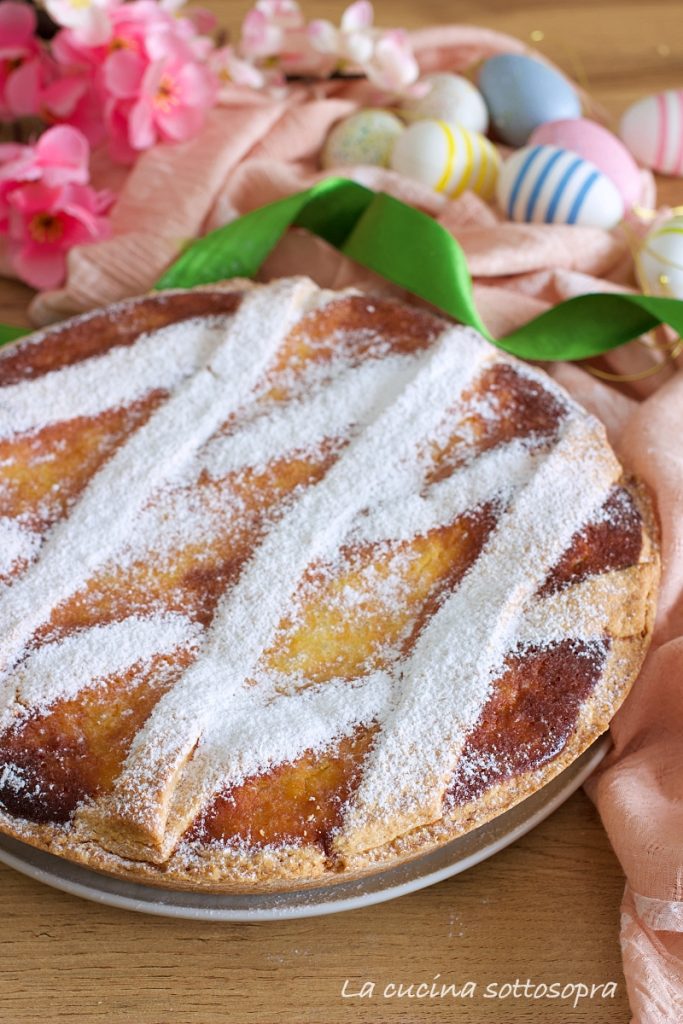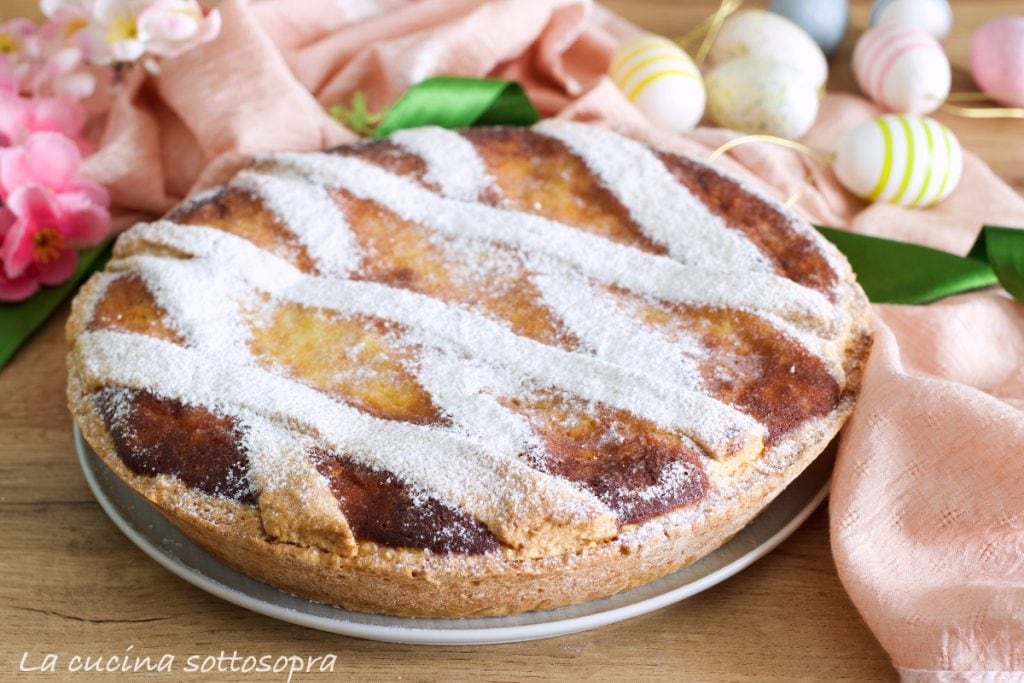Simone Esposito’s pastiera is the traditional dessert I decided to make this year for Easter. Let me start by saying that I love pastiera and, in general, all ricotta desserts, but the preparation of pastiera has a fascinating and wonderful ritual of its own: the preparation of the shortcrust pastry, the cooking of the wheat in milk, the preparation of the pastiera on Holy Thursday, the number of strips that recall the layout of the ancient city of Naples.
Not to mention the industrial quantities of pastiere that are traditionally prepared, as various families wish each other Happy Easter by exchanging pastiere and traditional casatielli or stracciati. As always with traditional recipes, everyone has their family recipe and claims theirs is the best. A ritual repeated every year and beautiful both from a traditional and human perspective.
Returning to the recipe for Simone Esposito’s pastiera, this year I decided to try it because it seemed like a faster version of the classic pastiera, both due to the shorter resting times of the pastry and the fact that the wheat is not cooked in milk, because, as Simone Esposito rightly points out in one of his videos, the wheat used for the pastiera is already cooked. It would be different if you had to start from raw wheat to cook it. Additionally, I was very intrigued by his eggless shortcrust pastry made with water.
So, I ventured into preparing his recipe, and it was a great success. I managed to prepare it in an afternoon without any difficulty.
Believe me, it is truly delicious, with a creamy and not at all dry filling. I followed his recipe to the letter. I only used a bit more candied fruit for my personal taste and slightly modified the cooking times because my oven is new, and the heating elements are very powerful, but in the end, the pastiera’s crust was perfectly cooked, and the filling was really tasty. Well, now let’s see together Simone Esposito’s pastiera recipe: with the doses found in the recipe, you can prepare either one pastiera 11-12 inches in diameter or two 9-inch pastiere. Before moving on to the recipe and procedure, I’ll leave you the links to some other Easter desserts from my Puglia, where, among other things, they prepare for Easter a ricotta tart with chocolate chips (which in Bari is called “ricotta pizza”) or a lemon ricotta tart and the ricotta pie without crust.

- Difficulty: Easy
- Cost: Medium
- Rest time: 1 Day
- Preparation time: 1 Hour
- Portions: 12People
- Cooking methods: Oven
- Cuisine: Regional Italian
- Region: Campania
- Seasonality: Easter, Easter Monday
- Energy 623.16 (Kcal)
- Carbohydrates 98.46 (g) of which sugars 64.39 (g)
- Proteins 12.50 (g)
- Fat 21.54 (g) of which saturated 13.38 (g)of which unsaturated 7.59 (g)
- Fibers 2.09 (g)
- Sodium 157.89 (mg)
Indicative values for a portion of 235 g processed in an automated way starting from the nutritional information available on the CREA* and FoodData Central** databases. It is not food and / or nutritional advice.
* CREATES Food and Nutrition Research Center: https://www.crea.gov.it/alimenti-e-nutrizione https://www.alimentinutrizione.it ** U.S. Department of Agriculture, Agricultural Research Service. FoodData Central, 2019. https://fdc.nal.usda.gov
Ingredients for Simone Esposito’s Pastiera
- 4 cups all-purpose flour
- 1 cup granulated sugar
- 7 oz butter (or lard)
- 3.5 tbsp water (or 1 egg)
- 1/2 tsp baking powder for desserts
- 17.5 oz sheep ricotta
- 17.5 oz cooked wheat
- 2.5 cups granulated sugar
- 11 oz eggs (about 6 eggs)
- 1 vial orange blossom aroma (or millefiori)
- 1 packet vanillin
- 2 oz candied fruit (candied orange and citron)
Tools
- Pans 9 inches
- Rolling Pin
- Bowls
- Pastry Wheel
Steps to Prepare Simone Esposito’s Pastiera
Let’s see how to prepare the Neapolitan pastiera by Simone Esposito. Start with the shortcrust pastry, so that while it rests in the fridge, you can prepare the filling.
In a bowl, combine flour, sugar, room temperature butter, and start working the ingredients.
Then add the water or egg. Also, add a pinch of baking powder. Work the shortcrust pastry until you have a homogeneous dough. Wrap it in some plastic wrap and let it rest in the refrigerator for half an hour (or even a few hours if you prefer to prepare it in advance).
Now prepare the filling.
In a large bowl, sieve the ricotta and work it until you get a cream.
Then add the cooked wheat and mix well with a fork.
Also, add the sugar and work again until you get a smooth and silky cream.
At this point, add the eggs, orange blossom aroma (or millefiori), and vanillin (or vanilla extract). Work the cream again to incorporate all the ingredients well.
Finally, add the candied fruits. Generally, candied orange and citron are used. Use high-quality candied fruits, as they greatly affect the final taste of the pastiera.
Take a 11-12 inch pastiera pan or two 9 inch pans and grease them with lard.
Roll out the shortcrust pastry to a thickness of about 3/16 inch, place it in the pan, and trim the excess dough by running a pastry wheel along the edges of the mold.
Prick the bottom of the pastiera with a fork and then pour in the filling, leaving a few millimeters from the edge.
With the remaining dough, create the pastiera strips no wider than half an inch. Traditionally, there should be 7. Place them on the filling and trim the excess from the edges.
Preheat the oven to 375°F fan-forced and bake on the lower rack of the oven for about 40-45 minutes. However, I recommend adjusting according to the power of your oven, because I had to bake it at 355°F for about 40 minutes to make it cook perfectly without drying out.
The pastiera should be well-cooked and with an amber filling at the end of cooking.
Let it cool completely before removing it from the mold. I personally baked it on Friday afternoon and unmolded it only on Sunday morning.If you prefer, you can dust it with a bit of powdered sugar.

Storage
– Traditionally, pastiera is not stored in the refrigerator because the shortcrust shell would absorb too much moisture, but it is kept at room temperature, well-sealed, in a cool, dry place away from humidity.
However, if the temperatures are higher than normal, store it in the fridge, always well-sealed to avoid absorbing odors, and take it out in time to enjoy it at room temperature.
– It’s worth noting that cooking times change depending on the size of the pastiera. A larger pastiera requires much more time to cook well, so if you decide to prepare the pastiera in a 11-12 inch mold, lower the temperature to 320°F and extend the cooking times to an hour or more.
FAQ (Frequently Asked Questions)
Why is there always so much sugar in pastiera?
Sugar, along with candied fruits, served as a preservative for pastiera because, traditionally, pastiere are prepared on Holy Thursday to be consumed on Easter Sunday. If you don’t have this need, you can reduce the sugar in the various recipes you find.

